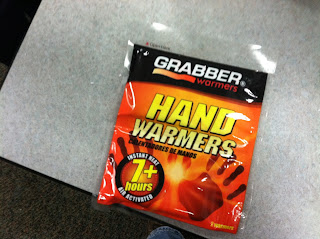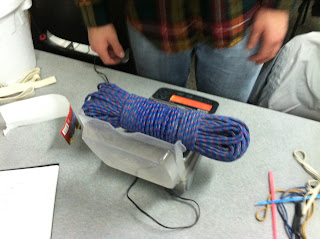For assignment 4, the class was split into groups of two to conduct a distance azimuth survey. Basically, this type of surveying involves using a handheld laser rangefinder that is equipped with an internal compass which can calculate the azimuth of the object of interest as well as finding the distance to said object. This type of surveying is considered pretty basic as there is more high tech equipment out there which provides better accuracy. However, one of the concepts we were trying to learn was that when the large, expensive equipment fails, what can be implemented as a reliable backup? So in our case, we were exposed to the so called backup option in the laser rangefinder. The exact name of the rangefinder is the TruPulse Laser Rangefinder (Fig. 1) of which more information can be found here: http://www.lasertech.com/TruPulse-Laser-Rangefinder.aspx. This piece of equipment is not exactly cheap either, and that is because it does offer many different capabilities as well as producing accurate results. Some of the different capabilites are: Distance, Inclination, Height, Azimuth, and Missing Line. The accuracy of this particular model is +/- 1ft. on a high quality object.
 |
| Fig. 1 |
Before we got started, we were introduced to the term DECLINATION. Declination refers to the difference between true north and magnetic north. Declination increases as one moves east or west away from the line where magnetic north and true north converge. When one moves west of this line, there will be negative declination and moving east will create a positive declination. One would then add if in a negative declination location in order to reach zero and subract in a positive declination location. Here is a map illustrating this below in Fig. 2.
 |
| Fig. 2 |
Maps are made based on magnetic north so that a compass can be used on them. Most maps put the declination formula on the map somewhere so that the user knows exactly what to calculate to compensate for this. Declination varies by year as well. One can easily find out what the declination is at any point on earth just by visiting a website that offers the formula where you just type in your zip code. Luckily, in Eau Claire, WI, we do not have to worry about calculating for declination as our declination for 2013 is: 0° 58' W changing by 0° 6' W/year, which is hardly anything! That being said, lets move on to the methodology for this project.
Methodology
For this exercise, we were instructed to use this device on a 1/4 hectare plot somewhere near campus and collect at least 50 points. We chose to collect point data on trees at Owen Park near the lower campus of UWEC. Here is a locational flowchart of the study area below in Fig. 3. |
| Fig. 3 |
The first thing we did upon getting to our survey location was to find a point of origin. We used a street sign that was along the road, which forms an island, in the park as our first origin and collected 27 points within the island. From there we moved to the north side of the island and then collected the remaining 23 points based off of a new point of origin. As Fig. 3 shows, there is an abundance of trees which allowed us to collect our 50 point rather quickly within half an hour. Once again, we only collected the distance from origin to each tree as well the azimuth. After we had all the data written down in a notebook, we took the data to the computer lab where all of the data was typed into an Excel spreadsheet so that in could be imported into a geodatabase in ArcMap. Here is a look at the data table in Fig. 4.
 |
| Fig. 4 |
 |
| Fig. 5
|
 |
| Fig. 6 |
Next, the line feature had to be converted to a point feature so that points could be plotted on the end of each line to indicate where each tree was located. The appropriate tool for this process is called the Feature Vertices to Point tool. Fig. 7 shows where this tool is located in ArcToolbox and Fig. 8 shows the result.
 |
| Fig. 7 |
 |
| Fig. 8 |
This exercise was a really fun exercise to conduct because we got to use some newer technology instead of having to use a compass and tape measurer! The end results looked pretty accurate overall. There are a few exceptions however as noted with the dots that are tossed outside of the tree island onto the roads and also a stray purple line heading towards the NE section of the image. This could come from writing down the wrong distance and/or azimuth for these points. Since the equipment we used is suppose to be very accurate, I think this is what happened. Another factor is that we tried to find our exact location via an aerial image instead of taking an exact coordinate location with a GPS. This then moves the point of origin, which also means the points will be moved as well. This is a beginner mistake that can be learned from for the next time a situation like this might arise. A more accurate survey could have been conducted with better equipment but that was not an option with this exercise. For mapping out trees and such, a laser rangefinder can be very useful. However, better equipment would be necessary to conduct a survey on a more professional project. Transit lasers and total stations are industry standard nowadays as these pieces of equipment are far more complex in nature and ensure a higher level of accuracy and reliability. It was definitely a good learning experience and is just another tool that can be used if that is all that is available or if your primary equipment fails in the field. The hardest part of this project was to get all of the data uploaded and showing up in the correct spot. Once everything was in a geodatabase and shared a common projection, there were no more issues. Had we had more detailed PointData, we could have selected out some of the lines based on tree species and assigned them a different color which would have looked really cool on the final map.




































